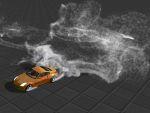Interactive Fluid-Particle Simulation using Translating Eulerian Grids

We describe an interactive system featuring fluid-driven animation that responds to moving objects. Our system includes a GPU accelerated Eulerian fluid solver that is suited for real-time use because it is unconditionally stable, takes constant calculation time per frame, and provides good visual fidelity. We dynamically translate the fluid simulation domain to track a user-controlled object. The fluid motion is visualized via its effects on particles which respond to the calculated fluid velocity field, but which are not constrained to stay within the bounds of the simulation domain. As particles leave the simulation domain, they seamlessly transition to purely particle-based motion, obscuring the point at which the fluid simulation ends. We additionally describe a hardware-accelerated volume rendering system that treats the particles as participating media and can render effects such as smoke, dust, or mist. Taken together, these components can be used to add fluid-driven effects to an interactive system without enforcing constraints on user motion, and without visual artifacts resulting from the finite extents of Eulerian fluid simulation methods.
Publication Date
Published in
Research Area
Uploaded Files
Copyright
Copyright by the Association for Computing Machinery, Inc. Permission to make digital or hard copies of part or all of this work for personal or classroom use is granted without fee provided that copies are not made or distributed for profit or commercial advantage and that copies bear this notice and the full citation on the first page. Copyrights for components of this work owned by others than ACM must be honored. Abstracting with credit is permitted. To copy otherwise, to republish, to post on servers, or to redistribute to lists, requires prior specific permission and/or a fee. Request permissions from Publications Dept, ACM Inc., fax +1 (212) 869-0481, or permissions@acm.org. The definitive version of this paper can be found at ACM's Digital Library http://www.acm.org/dl/.
